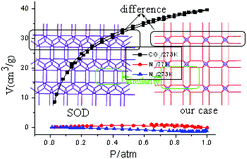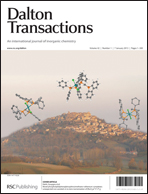Reported here is a new microporous metal–organic framework, namely [Zn2(L)(btc)(Hbtc)] [NH2(CH3)2]·(DMF)2 (H2O)4(1), which is synthesized solvo(hydro)thermally by the self-assembly of Zn(NO3)2, N4,N4-di(pyridin-3-yl)-[1,1′-biphenyl]-4,4′-dicarboxamide (L) and 1,3,5-benzenetricarboxylate acid (H3btc). Its topology can be described as a four-connecting 4264 matrix containing both tetrahedral metal and ligand nodes. Interestingly, such a matrix has the same topology symbol as that observed in the well known sodalite (SOD) net, but the td10 of 434 is different from the td10 of 791 for the SOD net, indicative of an exceptional four-connecting 4264 net. Another outstanding point is the highly selective adsorption of CO2 over N2, possibly contributed by a combined effect from the charged skeleton, the existence of functional groups of –CONH– and –COOH in 1.
You have access to this article
 Please wait while we load your content...
Something went wrong. Try again?
Please wait while we load your content...
Something went wrong. Try again?


 Please wait while we load your content...
Please wait while we load your content...